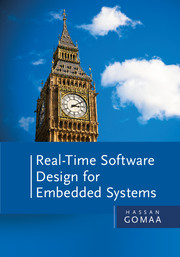Book contents
- Frontmatter
- Dedication
- Contents
- Preface
- Annotated Table of Contents
- Acknowledgments
- Part I Overview
- Part II Real-Time Software Design Method
- Part III Analysis of Real-Time Software Designs
- 16 System and Software Quality Attributes for Real-Time Embedded Systems
- 17 Performance Analysis of Real-Time Software Designs
- 18 Applying Performance Analysis to Real-Time Software Designs
- Part IV Real-Time Software Design Case Studies for Embedded Systems
- Appendix A Conventions Used in This Textbook
- Appendix B Catalog of Software Architectural Patterns
- Appendix C Pseudocode Templates for Concurrent Tasks
- Appendix D Teaching Considerations
- Glossary
- Bibliography
- Index
18 - Applying Performance Analysis to Real-Time Software Designs
from Part III - Analysis of Real-Time Software Designs
Published online by Cambridge University Press: 05 March 2016
- Frontmatter
- Dedication
- Contents
- Preface
- Annotated Table of Contents
- Acknowledgments
- Part I Overview
- Part II Real-Time Software Design Method
- Part III Analysis of Real-Time Software Designs
- 16 System and Software Quality Attributes for Real-Time Embedded Systems
- 17 Performance Analysis of Real-Time Software Designs
- 18 Applying Performance Analysis to Real-Time Software Designs
- Part IV Real-Time Software Design Case Studies for Embedded Systems
- Appendix A Conventions Used in This Textbook
- Appendix B Catalog of Software Architectural Patterns
- Appendix C Pseudocode Templates for Concurrent Tasks
- Appendix D Teaching Considerations
- Glossary
- Bibliography
- Index
Summary
This chapter applies the real-time performance analysis concepts and theory described in Chapter 17 to a real-time embedded system, namely the Light Rail Control System. The complete case study is described in Chapter 21. This chapter focuses on the real-time performance analysis using real-time scheduling theory and event sequence analysis.
Sections 18.1 through 18.3 provide a detailed example of analyzing the performance of the Light Rail Control System. Section 18.1 describes a performance analysis using event sequence analysis. Section 18.2 describes a performance analysis using real-time scheduling theory. Section 18.3 describes a performance analysis using both real-time scheduling theory and event sequence analysis. Section 18.4 describes design restructuring to meet performance goals.
EXAMPLE OF PERFORMANCE ANALYSIS USING EVENT SEQUENCE ANALYSIS
The example of performance analysis using event sequence analysis describes three time-critical event sequences for a train approaching a station, arriving at a station, and detecting a hazard. Assume that the first case to be analyzed is that of the Approaching Sensor detecting that the train is approaching a station at which it must stop, followed by the Arrival Sensor detecting that the train has arrived at the station. Assume also that the train is operating at the cruising speed. A performance requirement is that the system must respond to each of the approaching sensor and arrival sensor input events within 200 msec. The sequence of internal events following the approaching sensor input is depicted by the event sequence on the timing diagram in Figure 18.1, in which there are two hardware devices and four software tasks shown with their appropriate stereotypes (see Chapter 13). Tasks that are not involved in this scenario are excluded from the figure.
Assume that the Train Control state machine is in Cruising state. Consider the case of input from the approaching sensor. The event sequence is as follows, with the CPU time to process each event given in parentheses (where Ci is the CPU time required to process event i).
A0: Approaching Sensor sends an Approached event (i.e., interrupt) to the Approaching Sensor Input task to indicate that the train is approaching a station.
A1: The Approaching Sensor Input task receives an interrupt from the Approaching Sensor and reads the approaching sensor input.
A2: Approaching Sensor Input sends an Approached station message to Train Control.
- Type
- Chapter
- Information
- Real-Time Software Design for Embedded Systems , pp. 346 - 368Publisher: Cambridge University PressPrint publication year: 2016

